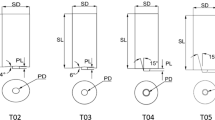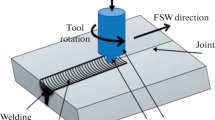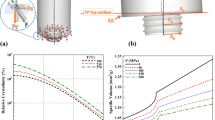Abstract
In this paper, we aim to investigate the heat generated during friction stir lap welding in polypropylene sheets. In this method, the generated heat significantly depends on the tool’s rotational and linear speed, geometry, and tilt angle. Heat analysis and measurement during welding are performed numerically to validate the experimental results. A 3-D symmetric Finite Element (FE) model was created to estimate the generated and distributed heat. As is shown, the heat is mainly generated around and underside the tool due to the high friction between the rotating tool and the workpiece. This paper provided a good intuition on the generated and distributed heat during the FSW process, which can be considered a reference to produce optimum and high-quality products with fewer tests. Therefore, in this paper, the effect of a number of parameters on the generated heat during the welding process is studied experimentally and statistically and simulated in three different levels. The obtained results demonstrated a significant relationship between the properties and process parameters using analysis of variance (ANOVA) and response surface method (RSM) (Box-Behnken). Moreover, the results revealed that the effect of parameter interactions could be evaluated using the proposed mathematical model by analyzing the presented plots. In addition, the results from the simulated model using finite element software and Altair’s HyperWorks confirmed the mathematical model estimations and the experimental results. The created model can successfully predict 92% of the welding joint temperature using the conditions and materials proposed in this paper. The results of the simulation analysis were validated and compared with the experimental tests, indicating a temperature difference of approximately 6%. The most effective parameter in heat generation is the rotational speed of the tool, which is responsible for up to 70% of the overall heat. Tool’s geometry (15%), traveling speed (11%), and tilt angle (4%) are the other parameters effective in generating heat in the process, in respective order.

















Similar content being viewed by others
References
Oliveira PH, Amancio ST, Dos Santos JF et al (2010) Preliminary study on the feasibility of friction spot welding in PMMA. J Mater Lett 64(19):2098–2101
Yousefpour A, Hojjati M, Immarigeon JP (2004) Fusion bonding/welding of thermoplastic composites. J Thermoplast Compos Mater 17(4):303–341
Huang Y, Meng X, Xie Y, Wan L, Lv Z, Cao J, Feng J (2018) Friction stir welding/ processing of polymers and polymer matrix composites. Compos A: J Appl Sci Manuf 105:235–257
Nandan R, DebRoy T, Bhadeshia HKDH (2008) Recent advances in friction-stir welding–process, weldment structure and properties. Prog Mater Sci 53(6):980–1023
Mishra RS, Ma ZY (2005) Friction stir welding and processing. Mater Sci Eng 50:1–78
Huang Y, Meng X, Xie Y, Lv Z, Wan L, Cao J, Feng J (2018) Friction spot welding of carbon fiber-reinforced polyetherimide laminate. Compos Struct 189:627–634
Amini A, Asadi P, Zolghadr P (2014) Friction stir welding applications in industry. Advances in friction-stir welding and processing. Woodhead Publishing Limited. Doi: https://doi.org/10.1533/9780857094551.671
Aghajani Derazkola H, Elyasi M (2018) The influence of process parameters in friction stir welding of Al-Mg alloy and polycarbonate. J Manuf Process 35:88–98
Meng X, Huang Y, Cao J et al (2021) Recent progress on control strategies for inherent issues in friction stir welding. Prog Mater Sci 115:1–74
Arici A, Selale S (2007) Effects of tool tilt angle on tensile strength and fracture locations of friction stir welding of polyethylene. J Sci Technol Weld Join 12(6):536–539
Payganeh GH, Arab NBM, Asl YD et al (2011) Effects of friction stir welding process parameters on appearance and strength ofpolypropylene composite welds. Int J Phys Sci 6:4595–4601
Shazly M, El-raey M (2014) Friction stir welding of polycarbonate sheets. In: Carpenter JS, Bai C, Hwang J-Y, Ikhmayies S, Li B, Monteiro SN, Peng Z, Zhang M (eds) Charaterization of minerals, metals and materials. Wiley, Hoboken, pp 555–563
Threadgill PL, Leonard AJ, Shercliff HR et al (2013) Friction stir welding of aluminium alloys. Int J Mater Rev 54:49–93
Aydin M (2010) Effects of welding parameters and preheating on the friction stir welding of UHMW-polyethylene. J Polym Plast Technol Eng 49(6):595–601
Squeo E, Bruno G, Guglielmotti A, Quadrini F (2009) Friction stir welding of polyethylene sheets. The Annals of Dunarea De Jos University of Galati, Fascicle V, Technologies in Machine Building, ISSN: 1221–4566: 241–246
Panneerselvam K, Lenin K (2013) Effects and defects of the polypropylene plate for different parameters in friction stir welding process. Int J Res Eng Technol 2:143–152
Arici A, Sinmaz T (2005) Effects of double passes of the tool on friction stir welding of polyethylene. J Mater Sci 40(12):3313–3316
Roth A, Hake T, Zaeh MF (2014) An analytical approach of modelling friction stir welding. Procedia CIRP 18:197–202
Zhang Z, Zhang HW (2008) A fully coupled thermo-mechanical model of friction stir welding. Int J Adv Manuf Technol 37(3–4):279–293
Li H, Liu D (2014) Simplified thermo-mechanical modeling of friction stir welding with a sequential FE method. Int J Model Optim 4(5):410–416
Mauricio, Pedro (2009) Modeling temperature distribution in friction stir welding using the finite element method. 20th international congress of mechanical engineering, November 15–20
Salloomi KN et al (2013) 3-dimensional nonlinear finite element analysis of both thermal and mechanical response of friction stir welded 2024-T3 aluminium plates. J Inf Eng Appl 3(9):6–15
Abdul Arif, et al. (2013) Finite element modelling for validation of maximum temperature in friction stir welding of aluminium alloy. 3rd international conference on production and industrial engineering, CPIE, at NIT, Jalandhar, Punjab
Huang Y, Xie Y, Meng X, Lv Z, Cao J (2018) Numerical design of high depth-to-width ratio friction stir welding. J Mater Process Technol 252:233–241
Armansyah et al (2014) Temperature distribution in friction stir welding using finite element method. World Acad Sci, Eng Technol, Int J Mech, Aerosp, Ind Mechatronics Eng 8(10):1699–1704
Kıral BG et al (2013) Finite element modeling of friction stir welding in aluminum alloys joint. Math Comput Appl 18(2):122–131
Zhang Z, Zhang HW (2009) Numerical studies on the effect of transverse speed in friction stir welding. Mater Des 30(3):900–907
Prasanna P et al (2010) Finite element modeling for maximum temperature in friction stir welding and its validation. Int J Adv Manuf Technol 51(9–12):925–933
Hasanzadeh R, Azdast T, Doniavia A, Lee RE (2019) Multi-objective optimization of heat transfer mechanisms of microcellular polymeric foams from thermal-insulation point of view. Therm Sci Eng Prog 9:21–29
Azdast T, Hasanzadeh R, Moradian M (2017) Optimization of process parameters in FSW of polymeric nanocomposites to improve impact strength using step wise tool selection. Mater Manuf Process 33(3):343–349
Mosavvar A, Azdast T, Moradian M, Hasanzadeh R (2019) Tensile properties of friction stir welding of thermoplastic pipes based on a novel designed mechanism. Weld World 63(3):691–699
Azdast T, Hasanzadeh R (2019) Experimental assessment and optimization of shrinkage behavior of injection molded polycarbonate parts. Mater Res Express 6(11):115334
Hasanzadeh R, Azdast T, Doniavi A, Rostami M (2019) A prediction model using response surface methodology based on cell size and foam density to predict thermal conductivity of polystyrene foams. Heat Mass Transf 55(10):2845–2855
Mendes N, Loureiro A, Martins C, Neto P, Pires JN (2014) Morphology and strength of acrylonitrile butadiene styrene welds performed by robotic friction stir welding. J Mater Des 64:81–90
Azarsa E, Mostafapour A (2014) Experimental investigation on flexural behavior of friction stir welded high density polyethylene sheets. J Manuf Process 16(1):149–155
Rahbarpour R, Azdast T, Rahbarpour H, Shishavan SM (2014) Feasibility study of friction stir welding of wood–plastic composites. J Sci Technol Weld Join 19(8):673–681
Mostafapour A, Asad FT (2016) Investigations on joining of nylon 6 plates via novel method of heat assisted friction stir welding to find the optimum process parameters. J Sci Technol Weld Join 21(8):660–669
Bagheri A, Azdast T, Doniavi A (2013) An experimental study on mechanical properties of friction stir welded ABS sheets. J Mater Des 43:402–409
Sajed M, Bisadi H (2016) Experimental failure study of friction stir spot welded similar and dissimilar aluminum alloys. J Weld World 60(1):33–40
Badarinarayan H, Shi Y, Li X, Okamoto K (2009) Effect of tool geometry on hook formation and static strength of friction stir spot welded aluminum 5754-O sheets. Int J Mach Tools Manuf 49(11):814–823
Box GEP, Behnken DW (1960) Some new three level designs for the study of quantitative variables. J Technometrics 2(4):455–475
Ferreira SLC, Bruns RE, Ferreira HS, Matos GD, David JM, Brandão GC, da Silva EGP, Portugal LA, dos Reis PS, Souza AS, dos Santos WNL (2007) Box-Behnken design: an alternative for the optimization of analytical methods. J Anal Chim Acta 597(2):179–186
Kamarei F, Ebrahimzadeh H, Yamini Y (2010) Optimization of solvent bar micro extraction combined with gas chromatography for the analysis of aliphatic amines in water samples. J Hazard Mater 178(1–3):747–752
Karthikeyan R, Balasubramanian V (2010) Predictions of the optimized friction stir spot welding process parameters for joining AA2024 aluminum alloy using RSM. Int J Adv Manuf Technol 51(1–4):173–1830
Khuri AL, Cornell J (1996) Response surfaces: design and analysis, 2nd edn. Marcel Dekker, New York
Khandkar MZH, Khan JA, Reynolds AP (2003) Prediction of temperature distribution and thermal history during friction stir welding: input torque based model. Sci Technol Weld Join 8(3):165–174
Woo W, Balogh L, Ungár T, Choo H, Feng Z (2008) Grain structure and dislocation density measurements in a friction-stir welded aluminum alloy using X-ray peak profile analysis. Mater Sci Eng A 498(1–2):308–313
Nandan R, Roy G, Lienert T, Debroy T (2007) Three-dimensional heat and material flow during friction stir welding of mild steel. Acta Mater 55(3):883–895
Ansari MA, Samanta A, Behnagh RA, Ding H (2019) An efficient coupled Eulerian-Lagrangian finite element model for friction stir processing. Int J Manuf Technol 101(5–8):1495–1508
Eskandari M, Aval HJ, Jamaati R (2019) The study of thermomechanical and microstructural issues in dissimilar FSW of AA6061 wrought and A390 cast alloys. J Manuf Process 4:168–176
Author information
Authors and Affiliations
Corresponding author
Ethics declarations
Conflict of interest
The authors declare that they have no conflict of interest.
Additional information
Publisher’s note
Springer Nature remains neutral with regard to jurisdictional claims in published maps and institutional affiliations.
Rights and permissions
About this article
Cite this article
Mirabzadeh, R., Parvaneh, V. & Ehsani, A. Experimental and numerical investigation of the generated heat in polypropylene sheet joints using friction stir welding (FSW). Int J Mater Form 14, 1067–1083 (2021). https://doi.org/10.1007/s12289-021-01622-y
Received:
Accepted:
Published:
Issue Date:
DOI: https://doi.org/10.1007/s12289-021-01622-y




